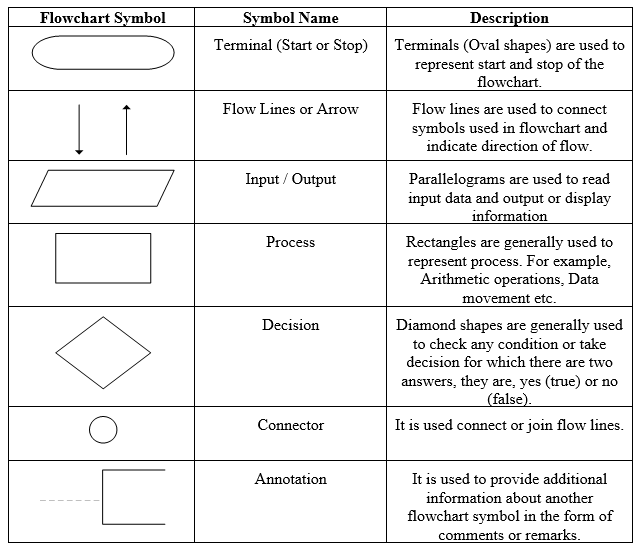Touchpad Plus Class 6,
Chapter 2. Basic Concept of Programming
1. Tick the correct option.
a. A computer programmer draws a _________ before writing a computer program.
- Chart
- Scenery
- Flowchart
- Syntax
Answer: Flowchart
b. Symbol of input and output box in a flowchart is ___________
- ▢
- ▱
- ○
- ◇
Answer: ▱
c. A flowchart is a graphical representation of a/an _______
- program
- algorithm
- symbol
- none of these
Answer: Algorithm
d. The language understood by the computer is ________
- Assembly language
- Machine language
- High-level language
- 4GL
Answer: Machine Language
e. _____is the third generation language.
- High-level language
- Machine language
- Assembly language
- Low-level language
Answer: High Level Language
2. Write 'T' for true and 'F' for false.
a. Algorithm uses various symbols to shows the process flow of the program. FALSE
b. In flowcharts, decision box is used to show the branches in the process flow. TRUE
c. Algorithm and flowchart are the same thing. FALSE
d. Assembly language is a first generation language. FALSE
e. High-level languages are machine independent. TRUE
3. Fill in the blanks using the words from the help box.
Connectors, Consistent, Instructions, Algorithm, Assembler
a. An algorithm is a collection of steps in a sequential manner.
b. The connectors are usually labeled in pairs to show matching jump points
c. A good flowchart will use consistent symbols.
d. A computer language is the means by which instructions are transmitted to the computer.
e. An assembler is a program used to translate assembly language into machine language.
4. Short answer type questions.
a. What is an algorithm?
Answer: An Algorithm is a set of steps in a sequential manner to solve a problem or to complete a task.
b. What is meant by a flowchart?
Answer: A flowchart is a graphical representation of the sequence of operations in an information system or program.
c. What is an assembler?
Answer: An assembler is a program used to translated assembly language into machine language so that the computer can understand it.
d. Write the names of any two third-generation languages.
Answer: The two third generation languages are C++ and Java
e. Define computer language.
Answer: To communicate with the computers, we need some special languages which are called computer languages or programming languages. A computer language is the medium by which instructions are transmitted to the computer to perform a specific task. It is a set of words, symbols and codes that the computer understand.
5. Long answer type questions:
a. What is the difference between HLL and LLL?
Answer: HLL stands for High level language is a programming language that enables a programmer to write programs that are machine independent. This type of languages are considered as high level languages because they are closer to human languages and away from machine languages.
LLL stands for Low Level Language is a programming language that is machine dependent. A program written in machine dependent language runs only on one particular type of computer. There are tow categories of low level language.
b. What are the advantages of High-level languages?
Answer: The advantage of High Level Languages are that they are easier to read, write and maintain.
Some Examples of high level languages are
Third Generation Languages - C++, Java, C#, BASIC, PASCAL, C, and FORTRAN
Forth Generation Languages - SQL, Perl, Python, etc.
Fifth Generation Language (Natural Language) - OPS5, Proolog, Mercury, etc.
C. Describe the use of the Process and the Input/Output symbols in the flowcharts.
Answer:




0 Comments